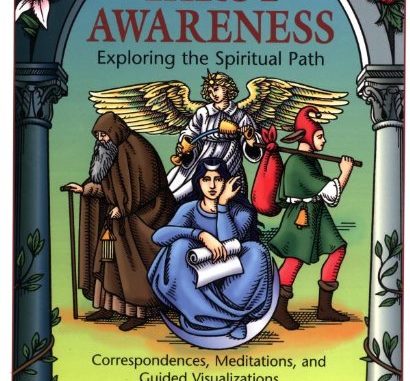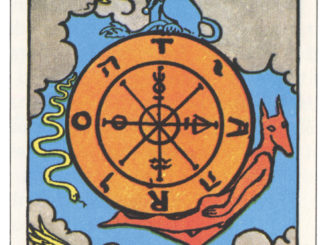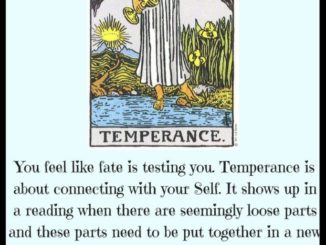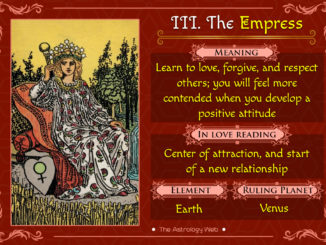
Though it is often considered just a fortune-telling device, Tarot cards are actually part of a much larger, centuries-old spiritual movement devoted to the discovery of the Higher Self. This movement, called the Western Mystery Tradition, encompasses and explores the many deep spiritual pathways found outside established western religious institutions; the treasure sought is an ever-deepening perception of our own humanity and relationship with the Divine, achieved by the process of understanding and transforming our own selves. Because of this approach, the Western Mystery Tradition is inclusive, rather than exclusive; it views all religious systems, including Tarot, as symbols and metaphors for the same Truth. Its wisdom is taught mainly through books and private meditation, and in small mystery schools around the world.
As with most esoteric spiritual systems, the goal of the Western Mystery Tradition is to lead us to higher levels of awareness, culminating in awakening or enlightenment, or, to use the Western Mystery Tradition term, “Initiation.” Tarot, therefore, as part of the Western Mystery Tradition, is more than a fortune-telling device – it is a legitimate spiritual path toward Initiation.
The early history of Tarot cards is not well-documented, which has given rise to many interesting but erroneous Tarot myths. One such myth claims the deck was created by a group of adepts who met periodically at some undisclosed location to discuss philosophy, magic, natural science, etc. Hampered by the lack of a common language, they created the Tarot deck to serve as their means of communication. Other myths place the origin of the cards in Egypt, India, China, Morocco or Mount Sinai. The word “Tarot” is thought to be Egyptian, Latin, Greek, Hebrew or, best of all, a mysterious anagram whose meaning has yet to be discovered.
The unromantic truth is that Tarot probably started out as a simple card game played in northern Italy during the early 15th century. The oldest Tarot cards still in existence are lavishly hand-painted decks that employ images familiar to Medieval and Renaissance European court life – kings, knights, fools, jugglers, etc. The word “Tarot” probably comes from the Italian Carte da Trionfi (Cards of the Triumphs), later called Tarocchi. The German form of the word is Tarock and the French form is Tarot.
The role of Tarot in spirituality began in the 18th century, when Comte de Mellet linked the 22 Major Arcana of the Tarot cards to the 22 letters of the Hebrew alphabet. Hebrew letters play an important role in the ancient Jewish mystical system called Kabbalah, which uses the Tree of Life as its main symbol. The Tree of Life is a metaphoric diagram that maps everything from the maturation of the self, our journeys from birth to death, and the progress of our souls toward Divinity. The Tree of Life has been studied for centuries; the earliest known reference to it is found in the Sefer Yetzirah, an ancient Kabbalistic text which may be almost two thousand years old.
This connection between Tarot, Hebrew letters and the Tree of Life was pursued by other students of the mysteries such as Eliphas Lévi in the 19th century. In 1909, Arthur Edward Waite and Pamela Coleman-Smith, both members of the Hermetic Order of the Golden Dawn and practicing Kabbalists, published the now-classic Rider-Waite Tarot deck, which is still the most popular Tarot deck in the world. Eventually, each Tarot card in the deck was assigned a place on the Tree of Life.
As a result of the classical education, research, study and devotion of esoteric scholars such as Levi, Waite, and Coleman-Smith, the Tarot deck was elevated from a simple plaything to a highly condensed symbolic learning device. By synthesizing a variety of traditions such as Kabbalah, astrology, alchemy and mythology, the Tarot images express spiritual truths that underlie much of western culture. These spiritual truths, expressed via iconic symbol and imagery, help build bridges between our conscious, subconscious and Higher Self. The secret of Tarot’s enduring popularity over the past several centuries is the way these simple, archetypal images communicate truths and deep meanings to all aspects of the self so directly.
The spiritual path of Tarot involves taking steps to incorporate the deeply felt meaning of each card into our everyday lives. Reading books about the cards is a good first step toward understanding these meanings more consciously. You might also select one card to be your companion for a week, keeping it with you as you go about your daily routine. Meditating on the images is also important. If this card could speak, what would it say to you? What aspect of your self is reflected in the image? What events in your daily life might be understood differently with the card’s message in mind? It’s a good idea to keep a journal of your thoughts, insights and personal issues as they arise throughout the week.
In addition to studying the cards themselves, understanding the sequence of the cards teaches us a great deal about the joys and sorrows of the spiritual path. For example, the Major Arcana chart a path that begins with The Fool, which represents the beginning of the Divine’s descent into physical reality. The next several cards teach us about the process by which man creates his world. Surprisingly, The Devil is the beginning of the path to Initiation, because it helps us see through the mask worn by the physical world. The next step is The Tower, which graphically demonstrates the pain and fear we experience by relinquishing strongly held opinions and worldviews. The cards that follow symbolize further stages on the path to full enlightenment or Initiation, symbolized by The World.
The Tarot’s Court Cards represent aspects of our own personalities that help and hinder us on our paths. The Minor Arcana represent aspects of the Tree of Life, which swing back and forth between positive and negative, male and female.
The depth and relevance of the wisdom and personal insights available through the Tarot is surprising. Once the symbolic bridge has been built, these cards actually seem to speak to us; the more we study them, the more they reveal. Because the symbols hidden in these cards derive from the history, myths, meaning and structure of western culture, Tarot is a powerful and appropriate practice for anyone on a western spiritual path.
Proudly WWW.PONIREVO.COM
by Amy Wall



